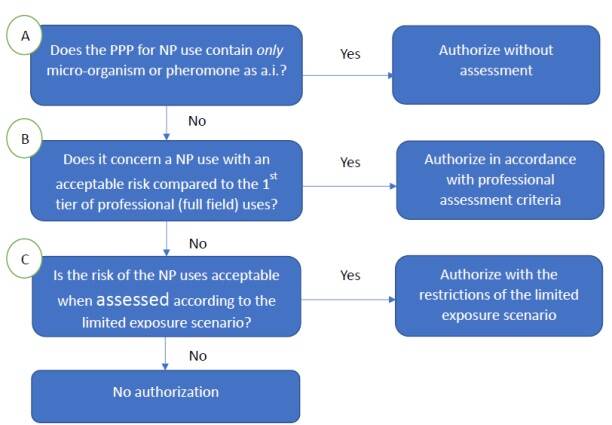Non-professional spray applications of plant protection products, a new approach to the higher tier assessment (ecotoxicology)
Authorisations for non-professional use of plant protection products are regularly applied for. This involves a wide range of products such as sticks for flower pots, granules and powders, and sprays for use both indoors and outdoors. For non-professional uses, a specific, harmonised approach to assess ecotoxicological risks is not yet available. A spray for non-professional use is therefore initially assessed for professional use. However, this generic approach has not worked very well, because home gardening and arable farming (professional monoculture) cannot be compared. Until a harmonised approach becomes available, the Ctgb therefore follows an internal policy line for non-professional use of sprays that is based on a decision tree. This simplifies the authorisation process, especially regarding the ecotoxicology assessment for certain low-risk products. For other applications for non-professional uses – such as uses based on granulates, drenching treatments or sticks – an assessment will be performed in accordance with the current framework and then submitted to the Board.
For ecotoxicological risks, non -professional (NP) applications, especially for home and garden uses, are assessed according to the professional assessment framework. When unacceptable risks are identified in the 1st tier, the professional assessment framework is not effective for performing a higher tier risk assessment. Private gardens are not comparable with professional monoculture. For this reason, a simplified 'higher tier' for these NP spray applications has been developed (see decision tree).
For other non-professional uses – such as uses based on granulates, drenching treatments or sticks – for the time being an assessment in accordance with the current assessment framework will be performed and submitted to the Board
In the Netherlands, the amount of plant protection product per package may cover a maximum area of 500 m2 to be treated (Bgb, Article 32aa) with the following restriction sentence in the legal conditions for use: Intended solely for private use in homes and/or gardens or allotments and/or greenhouses.
For ecotoxicological risks, non -professional (NP) applications, especially for home and garden uses, are assessed according to the professional assessment framework. When unacceptable risks are identified in the 1st tier, the professional assessment framework is not effective for performing a higher tier risk assessment. Private gardens are not comparable with professional monoculture. For this reason, a simplified 'higher tier' for these NP spray applications has been developed (see decision tree).
For other non-professional uses – such as uses based on granulates, drenching treatments or sticks – for the time being an assessment in accordance with the current assessment framework will be performed and submitted to the Board.
Step A. First of all, a distinction is made between products based on micro-organisms/pheromones and products with other types of active substances (e.g. oils/fatty acids/synthetic agents). Due to the low foreseeable risks of products based only on micro-organisms and pheromones (as active substances), no additional assessment is considered necessary.
Step B. If the product does not comply with step A, the requested GAP is assessed according to the 1st tier of the professional assessment framework (if a professional use has also been applied for in addition to a non-professional use, this serves as the basis for a possible higher tier expert judgement). If no acceptable risk is demonstrated, the product must comply with the limited exposure criteria referred to under Step C.
Step C. The three criteria of limited exposure:
- The requested GAP is limited to one (1) use or a maximum of two (2) uses, when these uses can be considered separate due to the interval and chemical properties.
- The maximum crop production area per use has been reduced from 500 m2 to 50 m2.
- Only for ready-to-use (RTU) packaging with sufficient volume for treating a maximum area of 50 m2
If all the limited exposure criteria are met and the use can be limited by means of RTU packaging for single use (or a maximum of two (2) uses that can be considered as separate) with a volume (content) that is sufficient for up to 50 m2 per use, authorisation can still be expected for many products (especially low-risk products).
If these criteria for limited exposure do not lead to an acceptable risk, no authorisation is possible.
This method was also discussed at the central zone workshop and was positively received.
It will come into effect for new applications after inclusion in the next update of the Evaluation Manual. As part of the new application for non-professional use, applicants are requested to indicate which steps of the decision tree they consider relevant and whether the limited exposure criteria apply.
For previously submitted and pending applications for non-professional spray uses, applicants can still submit a request to use this new method when this is appropriate during the application process, i.e. when answering questions from the intake (missing data) or from the assessment (additional questions). It is advisable to make an agreement about this in advance with the project leader.
If the GAP has to be changed to comply with the limited exposure criteria (step C), the applicant must ensure that the efficacy is still sufficiently substantiated. An additional assessment of efficacy may then be necessary.
